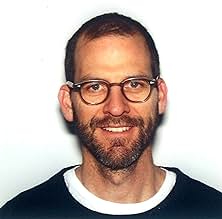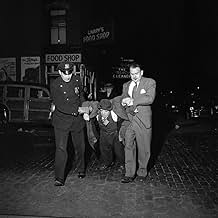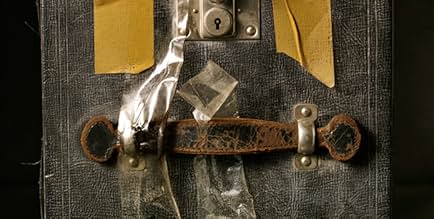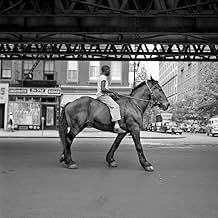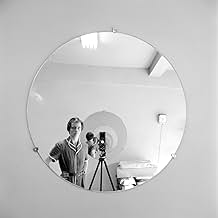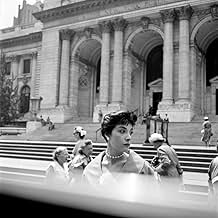IMDb-BEWERTUNG
7,7/10
15.572
IHRE BEWERTUNG
Ein Dokumentarfilm über die verstorbene Vivian Maier, ein Kindermädchen, deren bis dahin unbekannte 100.000 Fotografien ihr den posthumen Ruf als beste Straßenfotografin eingebracht haben.Ein Dokumentarfilm über die verstorbene Vivian Maier, ein Kindermädchen, deren bis dahin unbekannte 100.000 Fotografien ihr den posthumen Ruf als beste Straßenfotografin eingebracht haben.Ein Dokumentarfilm über die verstorbene Vivian Maier, ein Kindermädchen, deren bis dahin unbekannte 100.000 Fotografien ihr den posthumen Ruf als beste Straßenfotografin eingebracht haben.
- Regie
- Drehbuch
- Hauptbesetzung
- Für 1 Oscar nominiert
- 12 Gewinne & 23 Nominierungen insgesamt
Vivian Maier
- Self
- (Archivfilmmaterial)
Jeffrey 'Guffy' Levant
- Self - Interview Subject
- (as Jeffrey 'Duffy' Levant)
Empfohlene Bewertungen
The documentary "Finding Vivian Maier," written and directed by John Maloof and Charlie Siskel, tells the fascinating tale of a woman who lived and died in obscurity - then, through a serendipitous fluke of fate and an undiscovered talent for photography, became well known and celebrated long after her death. So much so that they even went and made a movie about her.
The saga began when Maloof, a young historian/filmmaker, bought a box of negatives at an auction in 2007. The negatives, it turned out, belonged to a woman named Vivian Maier, born in 1926, who had spent most of her adult life taking pictures of the world around her - more than 150,000 of them to be exact. Vivian never shared her work with the people in her life, even though the images were of a quality to rival some of the world's greatest and most famous photographers. Intrigued by what he had unearthed - the treasure trove included many 8 MM films as well - Maloof decided to re-create the life of this talented woman by seeking out those who knew her and using their knowledge of her to help piece it all together. It seems that Vivian spent her life as a nanny to the well-off families of Chicago; in fact, she was hired by no less a figure than Phil Donahue to look after his four children for a short time.
Through the movie, there emerges a portrait of an eccentric, intensely private woman, who never married and was seemingly devoid of family, who kept her personal background a secret, frequently used pseudonyms, affected a phony French accent (despite the fact that she was a native New Yorker), voiced strong opinions on politics and society, and traveled the world with only a camera for a companion, continually documenting, through both stills and film, the world as she and few others saw it.
One of the interviewees describes Vivian's work as reflecting "the bizarreness of life, the incongruencies of life, and the unappealing- ness of human beings." Yet, what comes through most vividly in her work is its humanity, her ability to capture the essence of people from all ages and walks of life in a single moment in time.
However, if you thought "Finding Vivian Maier" would turn out to be one of those unalloyed "feel good" movie experiences, you'd be sadly mistaken. For not everything we learn about the woman behind the camera is uplifting, charming and inspiring. In fact, the movie takes a decidedly dark turn in the latter half, as a number of the children she oversaw recount some of the abuse - both physical and emotional - they suffered at her hands.
She is described by some who knew her as "damaged" and "past eccentric,' riddled with mental illness, paranoia, and a compulsion for hoarding.
She became more and more isolated from the world as she entered old age, reduced to dumpster-diving for food. and becoming increasingly reliant on the kindness of strangers before death finally came for her in 2009.
Yet, now her work adorns the walls of many an art gallery the world over, as ever-increasing legions of admirers come to appreciate her talent.
For all its speculation, the movie demonstrates at least a certain amount of self-awareness by admitting that it may be a trifle unfair to judge a person and the life she led based entirely on how others saw and felt about her, without the person being given a chance to clarify or defend herself.
In a way, Vivian Maier is a stand-in for all the nameless, faceless people who surround us unnoticed, the vast majority of people who live their lives in relative obscurity and leave little real mark on the world after they're gone. Except, thanks to the fickle finger of fate and her own unique talent, Vivian did leave a mark, one that will be admired and appreciated for generations to come.
The saga began when Maloof, a young historian/filmmaker, bought a box of negatives at an auction in 2007. The negatives, it turned out, belonged to a woman named Vivian Maier, born in 1926, who had spent most of her adult life taking pictures of the world around her - more than 150,000 of them to be exact. Vivian never shared her work with the people in her life, even though the images were of a quality to rival some of the world's greatest and most famous photographers. Intrigued by what he had unearthed - the treasure trove included many 8 MM films as well - Maloof decided to re-create the life of this talented woman by seeking out those who knew her and using their knowledge of her to help piece it all together. It seems that Vivian spent her life as a nanny to the well-off families of Chicago; in fact, she was hired by no less a figure than Phil Donahue to look after his four children for a short time.
Through the movie, there emerges a portrait of an eccentric, intensely private woman, who never married and was seemingly devoid of family, who kept her personal background a secret, frequently used pseudonyms, affected a phony French accent (despite the fact that she was a native New Yorker), voiced strong opinions on politics and society, and traveled the world with only a camera for a companion, continually documenting, through both stills and film, the world as she and few others saw it.
One of the interviewees describes Vivian's work as reflecting "the bizarreness of life, the incongruencies of life, and the unappealing- ness of human beings." Yet, what comes through most vividly in her work is its humanity, her ability to capture the essence of people from all ages and walks of life in a single moment in time.
However, if you thought "Finding Vivian Maier" would turn out to be one of those unalloyed "feel good" movie experiences, you'd be sadly mistaken. For not everything we learn about the woman behind the camera is uplifting, charming and inspiring. In fact, the movie takes a decidedly dark turn in the latter half, as a number of the children she oversaw recount some of the abuse - both physical and emotional - they suffered at her hands.
She is described by some who knew her as "damaged" and "past eccentric,' riddled with mental illness, paranoia, and a compulsion for hoarding.
She became more and more isolated from the world as she entered old age, reduced to dumpster-diving for food. and becoming increasingly reliant on the kindness of strangers before death finally came for her in 2009.
Yet, now her work adorns the walls of many an art gallery the world over, as ever-increasing legions of admirers come to appreciate her talent.
For all its speculation, the movie demonstrates at least a certain amount of self-awareness by admitting that it may be a trifle unfair to judge a person and the life she led based entirely on how others saw and felt about her, without the person being given a chance to clarify or defend herself.
In a way, Vivian Maier is a stand-in for all the nameless, faceless people who surround us unnoticed, the vast majority of people who live their lives in relative obscurity and leave little real mark on the world after they're gone. Except, thanks to the fickle finger of fate and her own unique talent, Vivian did leave a mark, one that will be admired and appreciated for generations to come.
John Maloof buys one lot of photo negatives at a local auction house for $380 in 2007. He's looking for old pictures of Chicago to put in a picture book. He purchases the rest of the negatives from the other buyers and finds out after goggling that she was actually just a nanny. Her works find recognition as Maloof starts displaying them. She was also a pack rat and he pieces together her life from all of material she saved up. She seems like an eccentric private person who took pictures all the time. She would even bring her young charges to the slums to take interesting photographs. He continues to dig into her life and finds some fascinating mysteries.
First off, the pictures look beautiful. I really like the photos of people especially. Shooting from below gives a majesty to the subjects. That's the hook. Then there is the mystery of the nanny. It's a fascinating reveal as Maloof interview some of Vivian's charges. The fact that she seems to be alone raises the mystery factor. The only drawback is Maloof himself. There is probably some self serving purpose going on here and he's not the best narrator for the purpose. However I'm just drawn in by this private woman. I find her fascinating.
First off, the pictures look beautiful. I really like the photos of people especially. Shooting from below gives a majesty to the subjects. That's the hook. Then there is the mystery of the nanny. It's a fascinating reveal as Maloof interview some of Vivian's charges. The fact that she seems to be alone raises the mystery factor. The only drawback is Maloof himself. There is probably some self serving purpose going on here and he's not the best narrator for the purpose. However I'm just drawn in by this private woman. I find her fascinating.
Stories of posthumous success are always interesting. Rarely have they been on the scale of Vivian Maier, whose body of work proves that her perspective of the streets is not a fluke. The pictures are staggeringly good yet modest. She had a talent, if not one for printing and promotion. Elusive artists, ones who do it for their own satisfaction, are pretty fascinating. You think art should be one of those things that begs as much attention as possible. That was Vivian's enemy. Fortunately, or unfortunately for her, director John Maloof knows how to spread the word. Upon finding her photos and setting up galleries for them, he set out on a journey to find out more about her. He probes into all her facets. Her brilliance, her quirks, and her flaws. Perhaps Maloof shouldn't have had the gall to include himself, but he acts as an antithesis to Vivian. Almost an antagonist to her goal. It's a great dynamic that guides the film in a great way. Thoroughly entertaining, enlightening and engaging documentary with a beautiful score to boot. Finding Vivian Maier is easily of the best documentaries of the year.
8/10
8/10
This film is recommended.
Filmmaker John Maloof stumbles upon a trove of unwanted photos at an auction by a relatively unknown artist named Vivian Maier and this documentary, co-directed with Charlie Siskel, wants to make her well known and just may do so. His Antique Roadshow story becomes the basis for his documentary, Finding Vivian Maier, and it's almost too obvious that this filmmaker wants to create a legend and myth in this well done infomercial for this talented woman. Through interviews and archival footage of her photographic work, we learn little about this eccentric artist's life, she remain an enigma. But her photographic more than fulfills her lasting legacy.
To be honest, the film does not present a well balanced view of the late artist, and is purposely biased in its approach to heralding her fame. But Miss Maier's work, part Diane Arbus, Robert Frank, and Walker Evans, is certainly powerful. Her street photography is quite remarkable with a dark and insightful point of view.
Armed with a Rolleiflex camera, Maier shot over 100,000 photos of street life. Her imagery, mostly head shots of people on the streets of Chicago beginning in the 1960's, is varied and quite accomplished. Her photo journalistic style documents those times well into the 90's era. Her use of shadows and light are particularly effective and help to create a chilling mood with its subjects and their environs.
Finding Vivian Maier tries to uncover this artist's personal life, but never achieves that goal, due to conflicting stories by interviewees and the lack of physical evidence left by Maier herself. We take away from the film the fact that she was a private person whose main job was being a full-time nanny, although she may have possibly had severe mentally issues. She was a creative and prolific artist on the side, rarely printing or showing her own work to others. But we also take away from this biography a slightly disturbing feeling that the filmmakers might have an ulterior motive, taking advantage of the artist for purely financial reasons rather than mere admiration of her work. Some details (her early life, her friends and family members, her death) are glossed over instead of examined with any depth or mention.
That said, the filmmakers have assembled a compelling portrait of the photographer and her work is certainly worthy of attention. We may not find the real essence of the artist in the documentary, Finding Vivian Maier, but the journey itself and Vivian Maier's memorable imagery makes for fascinating viewing. GRADE: B
Visit my blog at: www.dearmoviegoer.com
ANY COMMENTS: Please contact me at: jadepietro@rcn.com
Filmmaker John Maloof stumbles upon a trove of unwanted photos at an auction by a relatively unknown artist named Vivian Maier and this documentary, co-directed with Charlie Siskel, wants to make her well known and just may do so. His Antique Roadshow story becomes the basis for his documentary, Finding Vivian Maier, and it's almost too obvious that this filmmaker wants to create a legend and myth in this well done infomercial for this talented woman. Through interviews and archival footage of her photographic work, we learn little about this eccentric artist's life, she remain an enigma. But her photographic more than fulfills her lasting legacy.
To be honest, the film does not present a well balanced view of the late artist, and is purposely biased in its approach to heralding her fame. But Miss Maier's work, part Diane Arbus, Robert Frank, and Walker Evans, is certainly powerful. Her street photography is quite remarkable with a dark and insightful point of view.
Armed with a Rolleiflex camera, Maier shot over 100,000 photos of street life. Her imagery, mostly head shots of people on the streets of Chicago beginning in the 1960's, is varied and quite accomplished. Her photo journalistic style documents those times well into the 90's era. Her use of shadows and light are particularly effective and help to create a chilling mood with its subjects and their environs.
Finding Vivian Maier tries to uncover this artist's personal life, but never achieves that goal, due to conflicting stories by interviewees and the lack of physical evidence left by Maier herself. We take away from the film the fact that she was a private person whose main job was being a full-time nanny, although she may have possibly had severe mentally issues. She was a creative and prolific artist on the side, rarely printing or showing her own work to others. But we also take away from this biography a slightly disturbing feeling that the filmmakers might have an ulterior motive, taking advantage of the artist for purely financial reasons rather than mere admiration of her work. Some details (her early life, her friends and family members, her death) are glossed over instead of examined with any depth or mention.
That said, the filmmakers have assembled a compelling portrait of the photographer and her work is certainly worthy of attention. We may not find the real essence of the artist in the documentary, Finding Vivian Maier, but the journey itself and Vivian Maier's memorable imagery makes for fascinating viewing. GRADE: B
Visit my blog at: www.dearmoviegoer.com
ANY COMMENTS: Please contact me at: jadepietro@rcn.com
10rxfore
This documentary is one of a kind. The story of an eccentric, possible mentally ill mystery woman and her prolific photographic work. If the move was just about her art, it would be extraordinary, as her work was. The story of her bizarre and secret life just enhance the film. For a first time effort from John Maloof, this one is very well done. The film starts with those who knew her, openly expressing their amazement to her unknown and mysterious life as a street photographer, filled with the images she kept a secret from everyone. You wonder how someone with her talent could keep it a secret for so long. Maloof plays a significant role in front of the camera as it is necessary for him to tell the story. When it is over, you are still left with a sense of disappointment. You know more about this mystery woman, yet you still crave for more..............And, the images still haunt you. This is one movie I will see numerous times.
The showing I attended had Jeff Garlin participate in a Q & A. It was entertaining as he detailed the process and effort Maloof put in to make this gem of a documentary.
The added bonus was my friends brother was in the film. Very exciting.
Please see this film if you can. Please see the photography of Vivian Maier if you can.
The showing I attended had Jeff Garlin participate in a Q & A. It was entertaining as he detailed the process and effort Maloof put in to make this gem of a documentary.
The added bonus was my friends brother was in the film. Very exciting.
Please see this film if you can. Please see the photography of Vivian Maier if you can.
Wusstest du schon
- VerbindungenFeatured in The Oscars (2015)
Top-Auswahl
Melde dich zum Bewerten an und greife auf die Watchlist für personalisierte Empfehlungen zu.
- How long is Finding Vivian Maier?Powered by Alexa
Details
- Erscheinungsdatum
- Herkunftsland
- Offizielle Standorte
- Sprachen
- Auch bekannt als
- Vivian Maier'in Peşinde
- Drehorte
- Produktionsfirma
- Weitere beteiligte Unternehmen bei IMDbPro anzeigen
Box Office
- Bruttoertrag in den USA und Kanada
- 1.514.782 $
- Eröffnungswochenende in den USA und in Kanada
- 63.600 $
- 30. März 2014
- Weltweiter Bruttoertrag
- 2.385.956 $
- Laufzeit
- 1 Std. 23 Min.(83 min)
- Farbe
- Seitenverhältnis
- 1.85 : 1
Zu dieser Seite beitragen
Bearbeitung vorschlagen oder fehlenden Inhalt hinzufügen






